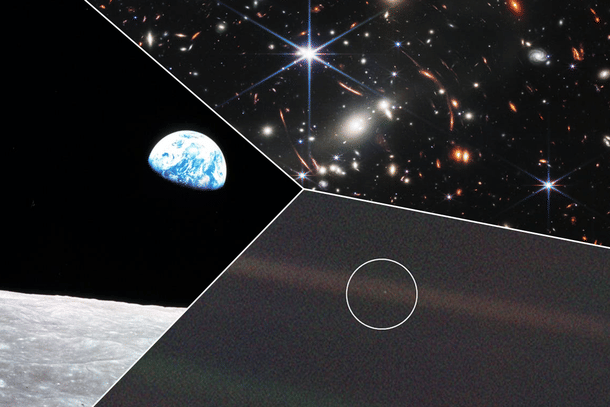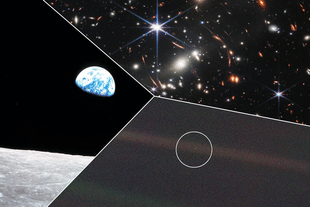Science
Why These Three Images Should Necessarily Be A Part Of Children's Education
Aravindan Neelakandan
Jul 13, 2022, 05:11 PM | Updated 05:15 PM IST
Save & read from anywhere!
Bookmark stories for easy access on any device or the Swarajya app.


Can we travel back in time to the very beginning of it all? The cosmic dawn? The primordial Ushas? Perhaps we are having a glimpse of the beginning of our current cycle of the universe as none before us have seen!
After a delay of a decade and a four years, and ten billion US dollars later, the James Webb Space Telescope (JWST) has brought us images of the deep space and early universe in an awe-inspiring way.
The blob like SMACS 0723's central galaxy is the main attraction of the images released by NASA. Its massive core is not a single entity but consists of many. These massive structures are difficult to study.
Some scientists have estimated a few of these clusters to be almost 839 trillion times the mass of our Sun. They are massive than even galaxies, leave alone individual stars. They are about 700 times the mass of the Andromeda galaxy.
The cluster is located 4.6 billion light-years away and these heavily massive structures bend the space and time around them and create what scientists call a 'gravitational lens'. Though it creates multiple images of the distant objects, the gravitational lens formed by SMACS 0723 allows as to 'see' and study the farthest stars as old as 13.1 billion years ago.

In other words we are looking at the universe at least 8 billion years before the earth was formed. That should be a deeply humbling and at the same time exhilarating spiritual experience.
At a very mundane level of global politics, the US needs this exhibition of its science capabilities as it sees the ascendancy of China as a major competitor in space. One who dominates the space and makes the world feel his dominance shall speak for the planet - all humanity.
From exploring the other side of the moon to growing a plant in space, China has been a serious competitor to the US which enjoyed a supremacy in space since its moon landing.
Now with the revealing of these images of cosmic dawn - a spectacular accomplishment that combines both high technical skills with images that shall define an achievement whose impact shall transcend national boundaries, the US is reasserting itself as the leader in science and technology for the planet.
Yes. Even when we are speaking about the expanse of space and time and the beginning of the universe, the puny artificial divisions on this insignificant corner of the universe play out their own importance in the human psyche.
But all these apart, this image is just like the image of the black hole at the centre of the galaxy, an important image. It communicates the immensity of the universe. This is an image not limited to science. This should not be an image limited to science.
Just as how the picture of 'earth rise' over the moon made us understand the oneness of the planet, just as how the famous 'pale blue dot' of Voyager 1 space probe made us understand ourselves in the proper perspective of deep space, this picture is also important.


It makes us understand our insignificance in terms of not just the cosmic space but also the immensity of the cosmic time. We are not even the blink of an eye.
We are not even a nanosecond in the deep cosmic time. Along with this realisation we also understand that we may actually be a rare phenomenon—not the only but still a rare phenomenon—in the sense that through us the universe looks at its own dawn.
So simultaneously we are nothing and we are precious to the cosmos. This paradox is at the basis of all spiritual experiences. This may be the womb of what Einstein called the 'cosmic religious experience'.
The aim and fulfilment of every religious education that any religion gives to a child should be this experience and everything else, the holy book or the practice or the belief - all should be an aid to prepare for this experience.
These three images should be present in every educational institution for children: 1) The image of SMACS 0723 by JWST; 2) the pale blue dot of Voyager 1 space probe; 3) and the 'Earthrise' captured from moon. This will impart to children a real spirituality that most religious doctrines cannot.
Also Read: First Ever Image Of The Black Hole At The Heart Of Milky Way Galaxy





